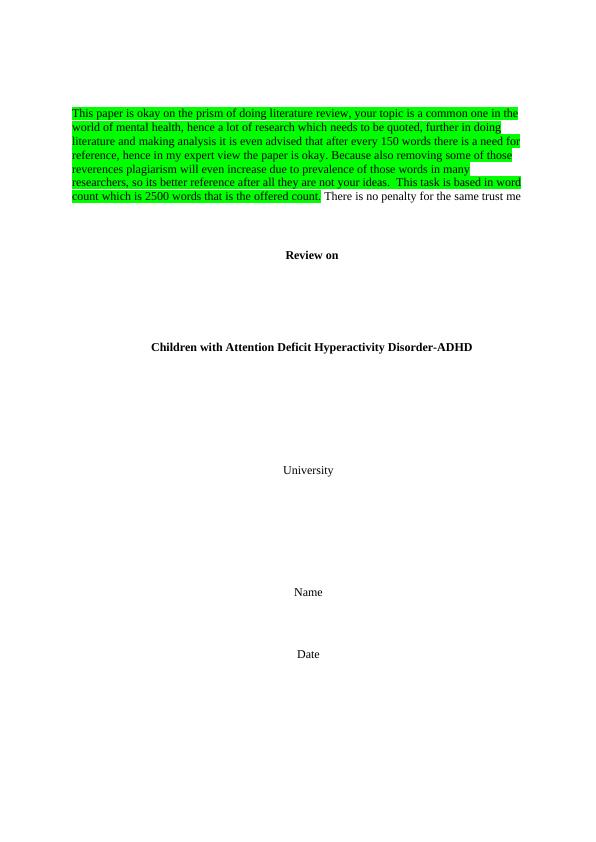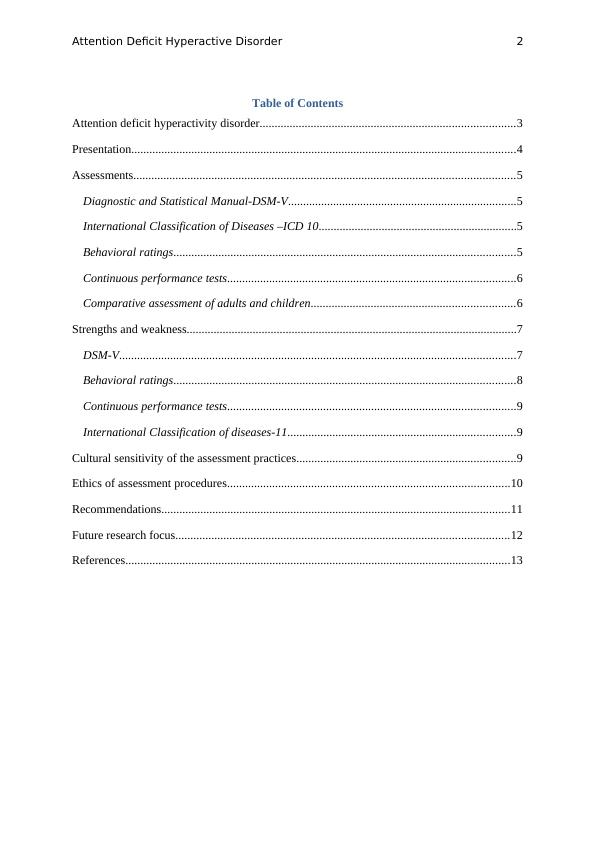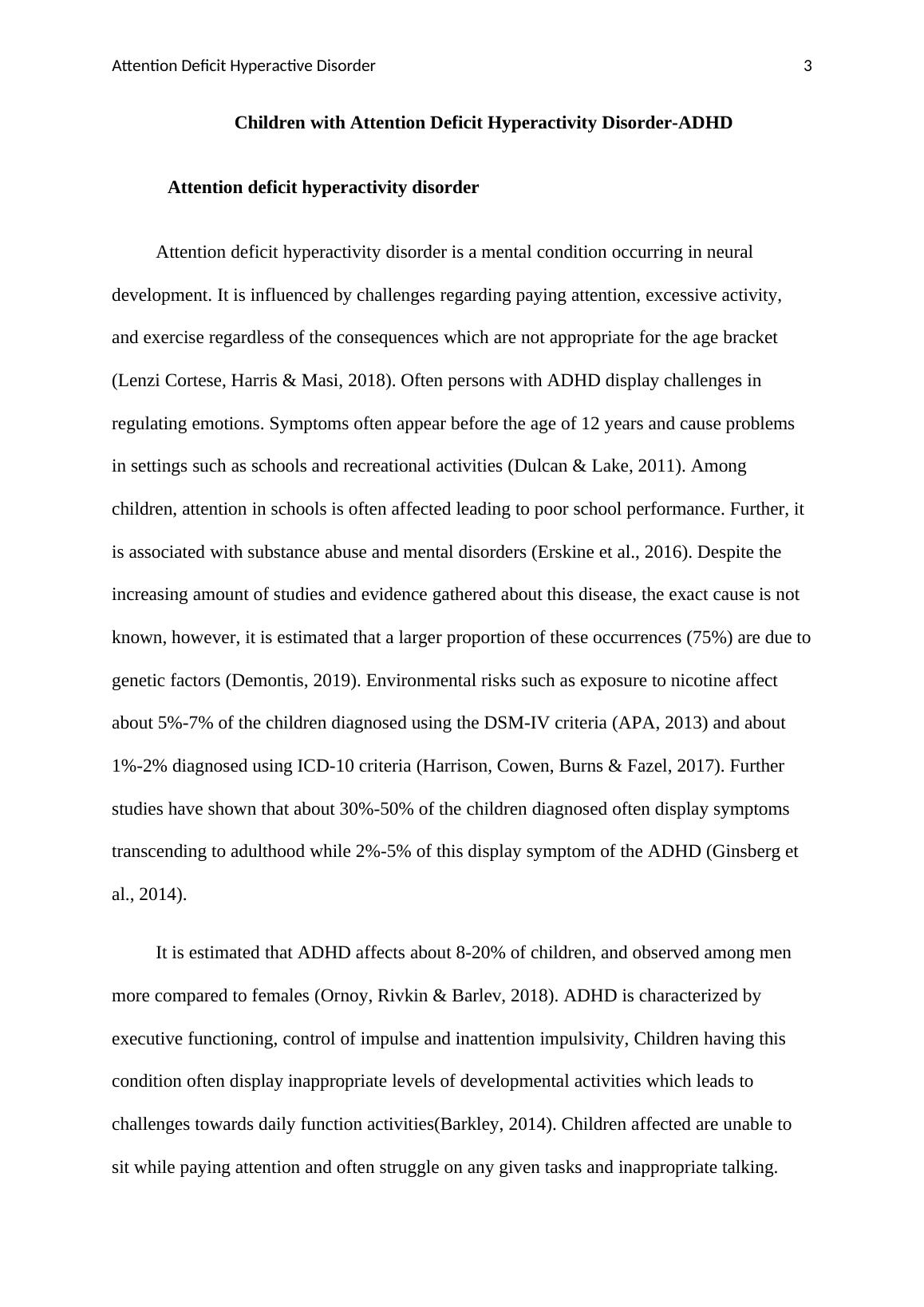Attention Deficit Hyperactive Disorder Report
16 Pages4352 Words16 Views
Added on 2022-09-12
Attention Deficit Hyperactive Disorder Report
Added on 2022-09-12
ShareRelated Documents
This paper is okay on the prism of doing literature review, your topic is a common one in the
world of mental health, hence a lot of research which needs to be quoted, further in doing
literature and making analysis it is even advised that after every 150 words there is a need for
reference, hence in my expert view the paper is okay. Because also removing some of those
reverences plagiarism will even increase due to prevalence of those words in many
researchers, so its better reference after all they are not your ideas. This task is based in word
count which is 2500 words that is the offered count. There is no penalty for the same trust me
Review on
Children with Attention Deficit Hyperactivity Disorder-ADHD
University
Name
Date
world of mental health, hence a lot of research which needs to be quoted, further in doing
literature and making analysis it is even advised that after every 150 words there is a need for
reference, hence in my expert view the paper is okay. Because also removing some of those
reverences plagiarism will even increase due to prevalence of those words in many
researchers, so its better reference after all they are not your ideas. This task is based in word
count which is 2500 words that is the offered count. There is no penalty for the same trust me
Review on
Children with Attention Deficit Hyperactivity Disorder-ADHD
University
Name
Date

Attention Deficit Hyperactive Disorder 2
Table of Contents
Attention deficit hyperactivity disorder.....................................................................................3
Presentation................................................................................................................................4
Assessments...............................................................................................................................5
Diagnostic and Statistical Manual-DSM-V............................................................................5
International Classification of Diseases –ICD 10..................................................................5
Behavioral ratings..................................................................................................................5
Continuous performance tests................................................................................................6
Comparative assessment of adults and children....................................................................6
Strengths and weakness..............................................................................................................7
DSM-V....................................................................................................................................7
Behavioral ratings..................................................................................................................8
Continuous performance tests................................................................................................9
International Classification of diseases-11............................................................................9
Cultural sensitivity of the assessment practices.........................................................................9
Ethics of assessment procedures..............................................................................................10
Recommendations....................................................................................................................11
Future research focus...............................................................................................................12
References................................................................................................................................13
Table of Contents
Attention deficit hyperactivity disorder.....................................................................................3
Presentation................................................................................................................................4
Assessments...............................................................................................................................5
Diagnostic and Statistical Manual-DSM-V............................................................................5
International Classification of Diseases –ICD 10..................................................................5
Behavioral ratings..................................................................................................................5
Continuous performance tests................................................................................................6
Comparative assessment of adults and children....................................................................6
Strengths and weakness..............................................................................................................7
DSM-V....................................................................................................................................7
Behavioral ratings..................................................................................................................8
Continuous performance tests................................................................................................9
International Classification of diseases-11............................................................................9
Cultural sensitivity of the assessment practices.........................................................................9
Ethics of assessment procedures..............................................................................................10
Recommendations....................................................................................................................11
Future research focus...............................................................................................................12
References................................................................................................................................13

Attention Deficit Hyperactive Disorder 3
Children with Attention Deficit Hyperactivity Disorder-ADHD
Attention deficit hyperactivity disorder
Attention deficit hyperactivity disorder is a mental condition occurring in neural
development. It is influenced by challenges regarding paying attention, excessive activity,
and exercise regardless of the consequences which are not appropriate for the age bracket
(Lenzi Cortese, Harris & Masi, 2018). Often persons with ADHD display challenges in
regulating emotions. Symptoms often appear before the age of 12 years and cause problems
in settings such as schools and recreational activities (Dulcan & Lake, 2011). Among
children, attention in schools is often affected leading to poor school performance. Further, it
is associated with substance abuse and mental disorders (Erskine et al., 2016). Despite the
increasing amount of studies and evidence gathered about this disease, the exact cause is not
known, however, it is estimated that a larger proportion of these occurrences (75%) are due to
genetic factors (Demontis, 2019). Environmental risks such as exposure to nicotine affect
about 5%-7% of the children diagnosed using the DSM-IV criteria (APA, 2013) and about
1%-2% diagnosed using ICD-10 criteria (Harrison, Cowen, Burns & Fazel, 2017). Further
studies have shown that about 30%-50% of the children diagnosed often display symptoms
transcending to adulthood while 2%-5% of this display symptom of the ADHD (Ginsberg et
al., 2014).
It is estimated that ADHD affects about 8-20% of children, and observed among men
more compared to females (Ornoy, Rivkin & Barlev, 2018). ADHD is characterized by
executive functioning, control of impulse and inattention impulsivity, Children having this
condition often display inappropriate levels of developmental activities which leads to
challenges towards daily function activities(Barkley, 2014). Children affected are unable to
sit while paying attention and often struggle on any given tasks and inappropriate talking.
Children with Attention Deficit Hyperactivity Disorder-ADHD
Attention deficit hyperactivity disorder
Attention deficit hyperactivity disorder is a mental condition occurring in neural
development. It is influenced by challenges regarding paying attention, excessive activity,
and exercise regardless of the consequences which are not appropriate for the age bracket
(Lenzi Cortese, Harris & Masi, 2018). Often persons with ADHD display challenges in
regulating emotions. Symptoms often appear before the age of 12 years and cause problems
in settings such as schools and recreational activities (Dulcan & Lake, 2011). Among
children, attention in schools is often affected leading to poor school performance. Further, it
is associated with substance abuse and mental disorders (Erskine et al., 2016). Despite the
increasing amount of studies and evidence gathered about this disease, the exact cause is not
known, however, it is estimated that a larger proportion of these occurrences (75%) are due to
genetic factors (Demontis, 2019). Environmental risks such as exposure to nicotine affect
about 5%-7% of the children diagnosed using the DSM-IV criteria (APA, 2013) and about
1%-2% diagnosed using ICD-10 criteria (Harrison, Cowen, Burns & Fazel, 2017). Further
studies have shown that about 30%-50% of the children diagnosed often display symptoms
transcending to adulthood while 2%-5% of this display symptom of the ADHD (Ginsberg et
al., 2014).
It is estimated that ADHD affects about 8-20% of children, and observed among men
more compared to females (Ornoy, Rivkin & Barlev, 2018). ADHD is characterized by
executive functioning, control of impulse and inattention impulsivity, Children having this
condition often display inappropriate levels of developmental activities which leads to
challenges towards daily function activities(Barkley, 2014). Children affected are unable to
sit while paying attention and often struggle on any given tasks and inappropriate talking.

Attention Deficit Hyperactive Disorder 4
These behaviors portray significant challenges especially in academic settings due to limited
focus and attention hence leading to poor performance.
Presentation
Hyperactivity, inattention, disruptive behavior and impulsive engagements are common
in ADHD. Academic challenges are often prevalent and also difficult in establishing
relationships. This makes it difficult for carers to draw a line on diagnostic procedures.
According to the 5th Diagnostic and Statistical Manual of Mental disorders- DSM-V
symptoms presented need to be 6 or more presenting a greater degree compared to others of
the same age and cause inherent and observable problems in at least two settings. Further, the
criteria need to be met before age twelve to receive a diagnosis of ADHD. ADHD is divided
into three domains; predominate inattentively (ADHD-P1 OR I), predominantly hyper-
reactive (ADHD-PH OR HI) and the combined type (ADHD-C).
Inattentive characteristics entail likely demonstrating activities such as inability to pay
close attention, difficulty in maintaining tasks, none attentive appearance, frequent
carelessness, easy distraction, forgetting tasks and challenges in following instructions. In the
predominantly hyperactive-impulsive state; the person is often on the constant on the go,
inability to be seated, persistent fidgeting, excessive talking, and difficulty in playing and
reluctant to take a turn. In a combined ADHD, the characteristics are often a combination of
the above two types.
Among children in schools, learning-based activities such as reading are affected. With
the challenges regarding ADHD, reading is often a difficult task for children. Further, they
often present with challenges and defects with regards to reading comprehension abilities
(Fienup et al., 2015).
These behaviors portray significant challenges especially in academic settings due to limited
focus and attention hence leading to poor performance.
Presentation
Hyperactivity, inattention, disruptive behavior and impulsive engagements are common
in ADHD. Academic challenges are often prevalent and also difficult in establishing
relationships. This makes it difficult for carers to draw a line on diagnostic procedures.
According to the 5th Diagnostic and Statistical Manual of Mental disorders- DSM-V
symptoms presented need to be 6 or more presenting a greater degree compared to others of
the same age and cause inherent and observable problems in at least two settings. Further, the
criteria need to be met before age twelve to receive a diagnosis of ADHD. ADHD is divided
into three domains; predominate inattentively (ADHD-P1 OR I), predominantly hyper-
reactive (ADHD-PH OR HI) and the combined type (ADHD-C).
Inattentive characteristics entail likely demonstrating activities such as inability to pay
close attention, difficulty in maintaining tasks, none attentive appearance, frequent
carelessness, easy distraction, forgetting tasks and challenges in following instructions. In the
predominantly hyperactive-impulsive state; the person is often on the constant on the go,
inability to be seated, persistent fidgeting, excessive talking, and difficulty in playing and
reluctant to take a turn. In a combined ADHD, the characteristics are often a combination of
the above two types.
Among children in schools, learning-based activities such as reading are affected. With
the challenges regarding ADHD, reading is often a difficult task for children. Further, they
often present with challenges and defects with regards to reading comprehension abilities
(Fienup et al., 2015).

End of preview
Want to access all the pages? Upload your documents or become a member.
Related Documents
Attention Deficit Hyperactivity Disorder: Symptoms, Diagnosis, and MFT Therapylg...
|14
|3912
|189
Interview analysis Assignment PDFlg...
|10
|2881
|45
Attention deficit hyperactivity disorder - Assignment PDFlg...
|9
|2693
|60
(PDF) Attention Deficit Hyperactivity Disorder (ADHD)lg...
|8
|1600
|37
Attention Deficit Hyperactivity Disorder1lg...
|15
|4094
|15
Investigation on teacher’s knowledge of Attention –Deficit Hyperactivity disorderlg...
|23
|2898
|303
